DODGE CHALLENGER 2015 3.G User Guide
Manufacturer: DODGE, Model Year: 2015, Model line: CHALLENGER, Model: DODGE CHALLENGER 2015 3.GPages: 220, PDF Size: 30.96 MB
Page 171 of 220
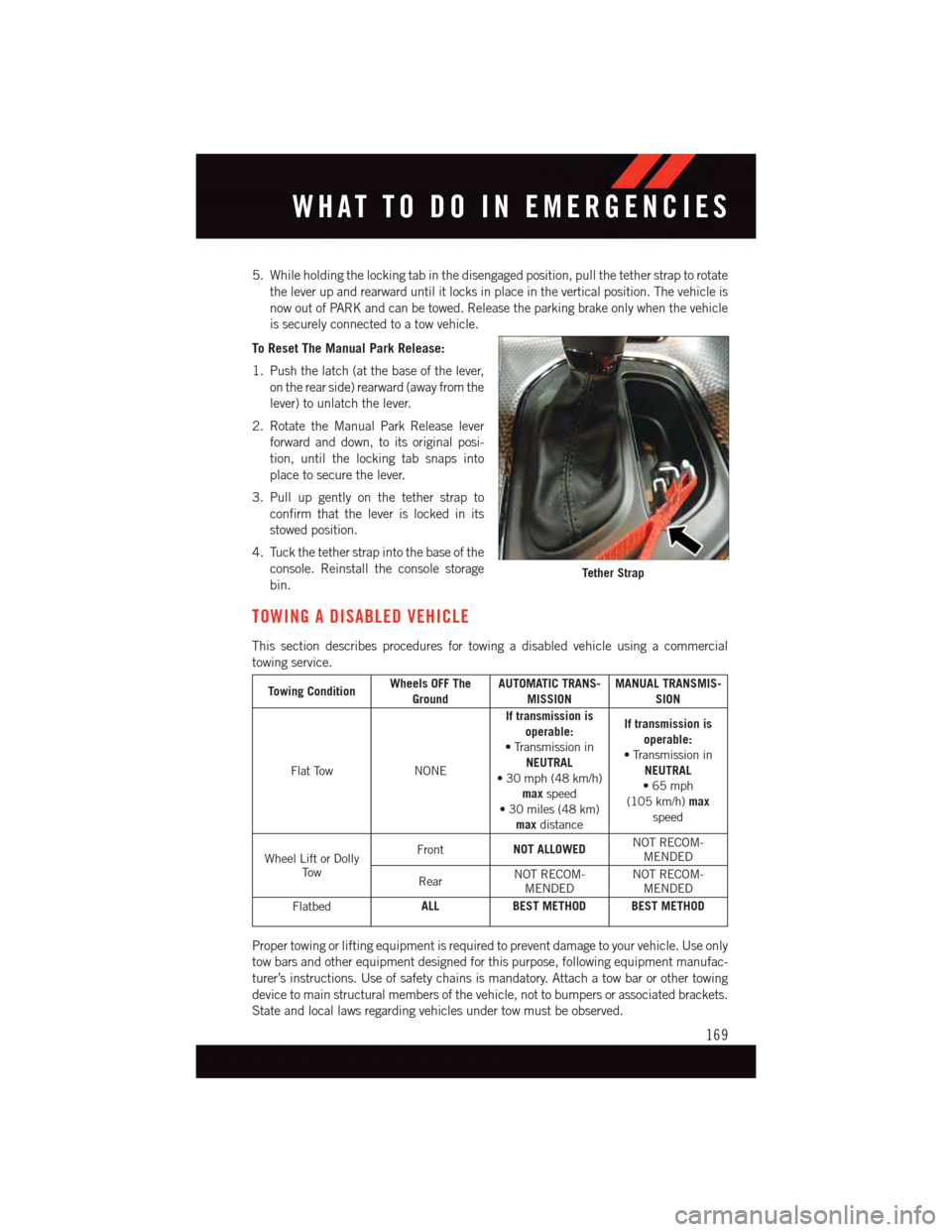
5. While holding the locking tab in the disengaged position, pull the tether strap to rotate
the lever up and rearward until it locks in place in the vertical position. The vehicle is
now out of PARK and can be towed. Release the parking brake only when the vehicle
is securely connected to a tow vehicle.
To Reset The Manual Park Release:
1. Push the latch (at the base of the lever,
on the rear side) rearward (away from the
lever) to unlatch the lever.
2. Rotate the Manual Park Release lever
forward and down, to its original posi-
tion, until the locking tab snaps into
place to secure the lever.
3. Pull up gently on the tether strap to
confirm that the lever is locked in its
stowed position.
4. Tuck the tether strap into the base of the
console. Reinstall the console storage
bin.
TOWING A DISABLED VEHICLE
This section describes procedures for towing a disabled vehicle using a commercial
towing service.
Towing ConditionWheels OFF TheGroundAUTOMATIC TRANS-MISSIONMANUAL TRANSMIS-SION
Flat TowNONE
If transmission isoperable:•TransmissioninNEUTRAL•30mph(48km/h)maxspeed•30miles(48km)maxdistance
If transmission isoperable:•TransmissioninNEUTRAL•65mph(105 km/h)maxspeed
Wheel Lift or DollyTo w
FrontNOT ALLOWEDNOT RECOM-MENDED
RearNOT RECOM-MENDEDNOT RECOM-MENDED
FlatbedALLBEST METHOD BEST METHOD
Proper towing or lifting equipment is required to prevent damage to your vehicle. Use only
tow bars and other equipment designed for this purpose, following equipment manufac-
turer’s instructions. Use of safety chains is mandatory. Attach a tow bar or other towing
device to main structural members of the vehicle, not to bumpers or associated brackets.
State and local laws regarding vehicles under tow must be observed.
Tether Strap
WHAT TO DO IN EMERGENCIES
169
Page 172 of 220
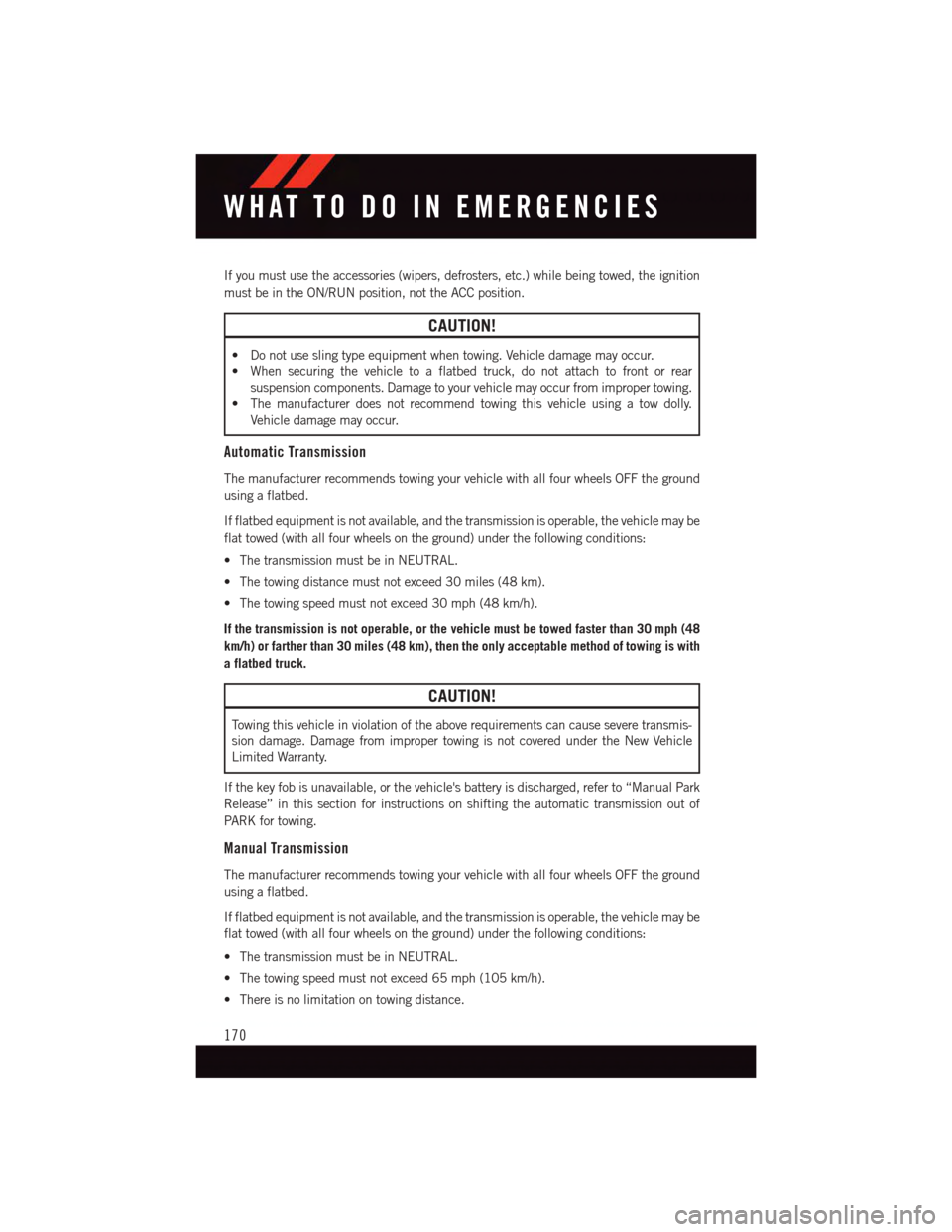
If you must use the accessories (wipers, defrosters, etc.) while being towed, the ignition
must be in the ON/RUN position, not the ACC position.
CAUTION!
•Donotuseslingtypeequipmentwhentowing.Vehicledamagemayoccur.
•Whensecuringthevehicletoaflatbedtruck,donotattachtofrontorrear
suspension components. Damage to your vehicle may occur from improper towing.
•Themanufacturerdoesnotrecommendtowingthisvehicleusingatowdolly.
Vehicle damage may occur.
Automatic Transmission
The manufacturer recommends towing your vehicle with all four wheels OFF the ground
using a flatbed.
If flatbed equipment is not available, and the transmission is operable, the vehicle may be
flat towed (with all four wheels on the ground) under the following conditions:
•ThetransmissionmustbeinNEUTRAL.
•Thetowingdistancemustnotexceed30miles(48km).
•Thetowingspeedmustnotexceed30mph(48km/h).
If the transmission is not operable, or the vehicle must be towed faster than 30 mph (48
km/h) or farther than 30 miles (48 km), then the only acceptable method of towing is with
a flatbed truck.
CAUTION!
To w i n g t h i s v e h i c l e i n v i o l a t i o n o f t h e a b o v e r e q u i r e m e n t s c a n c a u s e s e v e r e t r a n s m i s -
sion damage. Damage from improper towing is not covered under the New Vehicle
Limited Warranty.
If the key fob is unavailable, or the vehicle's battery is discharged, refer to “Manual Park
Release” in this section for instructions on shifting the automatic transmission out of
PA R K f o r t o w i n g .
Manual Transmission
The manufacturer recommends towing your vehicle with all four wheels OFF the ground
using a flatbed.
If flatbed equipment is not available, and the transmission is operable, the vehicle may be
flat towed (with all four wheels on the ground) under the following conditions:
•ThetransmissionmustbeinNEUTRAL.
•Thetowingspeedmustnotexceed65mph(105km/h).
•Thereisnolimitationontowingdistance.
WHAT TO DO IN EMERGENCIES
170
Page 173 of 220
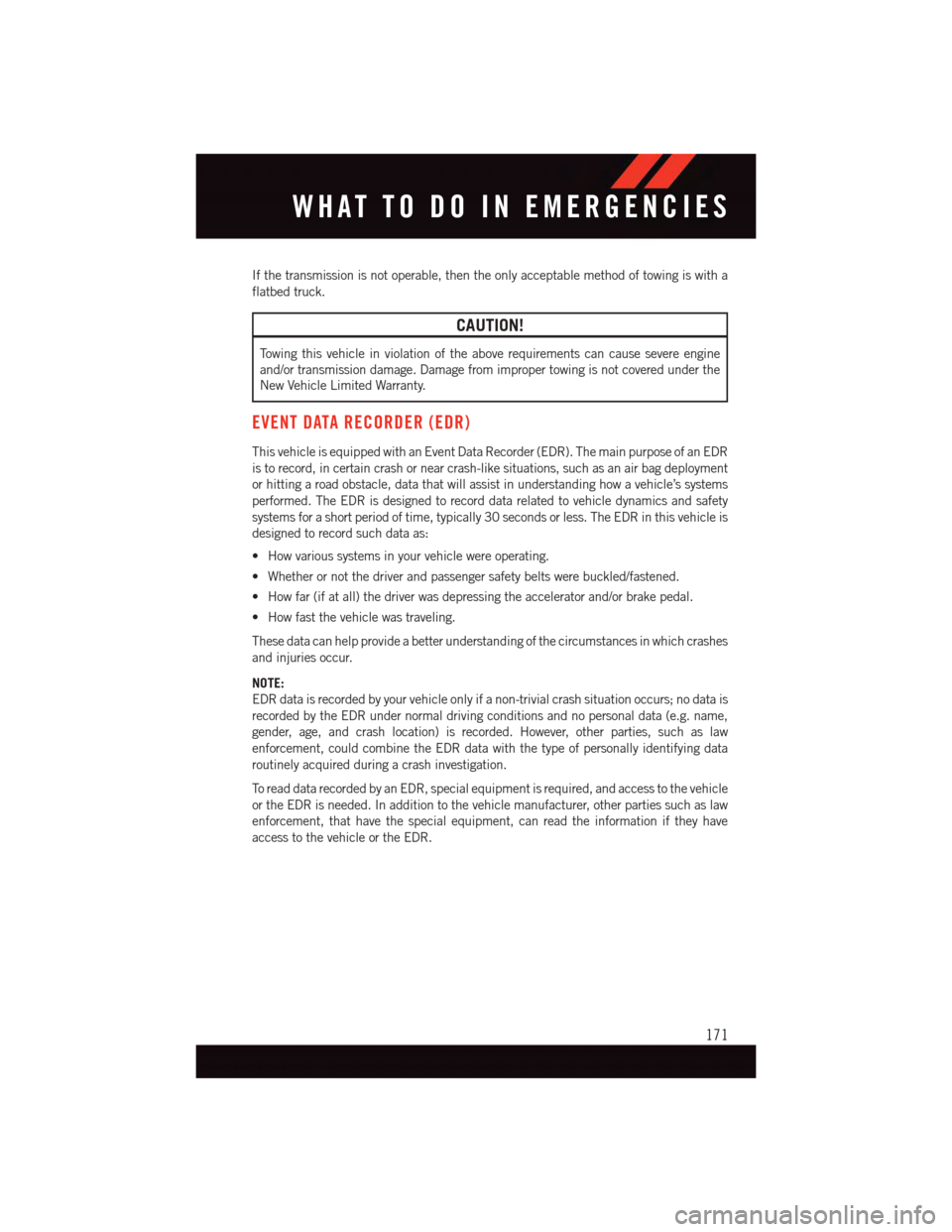
If the transmission is not operable, then the only acceptable method of towing is with a
flatbed truck.
CAUTION!
To w i n g t h i s v e h i c l e i n v i o l a t i o n o f t h e a b o v e r e q u i r e m e n t s c a n c a u s e s e v e r e e n g i n e
and/or transmission damage. Damage from improper towing is not covered under the
New Vehicle Limited Warranty.
EVENT DATA RECORDER (EDR)
This vehicle is equipped with an Event Data Recorder (EDR). The main purpose of an EDR
is to record, in certain crash or near crash-like situations, such as an air bag deployment
or hitting a road obstacle, data that will assist in understanding how a vehicle’s systems
performed. The EDR is designed to record data related to vehicle dynamics and safety
systems for a short period of time, typically 30 seconds or less. The EDR in this vehicle is
designed to record such data as:
•Howvarioussystemsinyourvehiclewereoperating.
•Whetherornotthedriverandpassengersafetybeltswerebuckled/fastened.
•Howfar(ifatall)thedriverwasdepressingtheacceleratorand/orbrakepedal.
•Howfastthevehiclewastraveling.
These data can help provide a better understanding of the circumstances in which crashes
and injuries occur.
NOTE:
EDR data is recorded by your vehicle only if a non-trivial crash situation occurs; no data is
recorded by the EDR under normal driving conditions and no personal data (e.g. name,
gender, age, and crash location) is recorded. However, other parties, such as law
enforcement, could combine the EDR data with the type of personally identifying data
routinely acquired during a crash investigation.
To r e a d d a t a r e c o r d e d b y a n E D R , s p e c i a l e q u i p m e n t i s r e q u i r e d , a n d a c c e s s t o t h e v e h i c l e
or the EDR is needed. In addition to the vehicle manufacturer, other parties such as law
enforcement, that have the special equipment, can read the information if they have
access to the vehicle or the EDR.
WHAT TO DO IN EMERGENCIES
171
Page 174 of 220
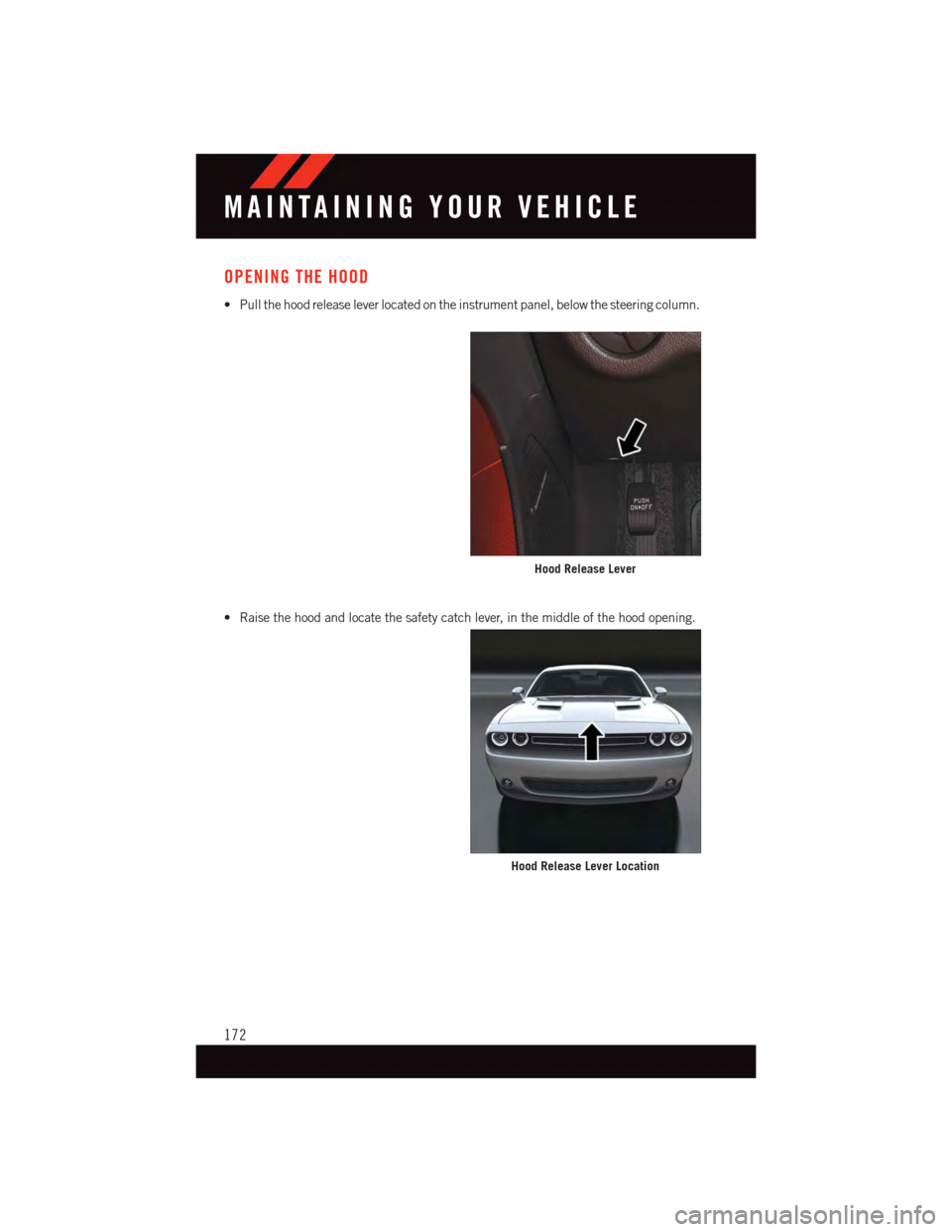
OPENING THE HOOD
•Pullthehoodreleaseleverlocatedontheinstrumentpanel,belowthesteeringcolumn.
•Raisethehoodandlocatethesafetycatchlever,inthemiddleofthehoodopening.
Hood Release Lever
Hood Release Lever Location
MAINTAINING YOUR VEHICLE
172
Page 175 of 220
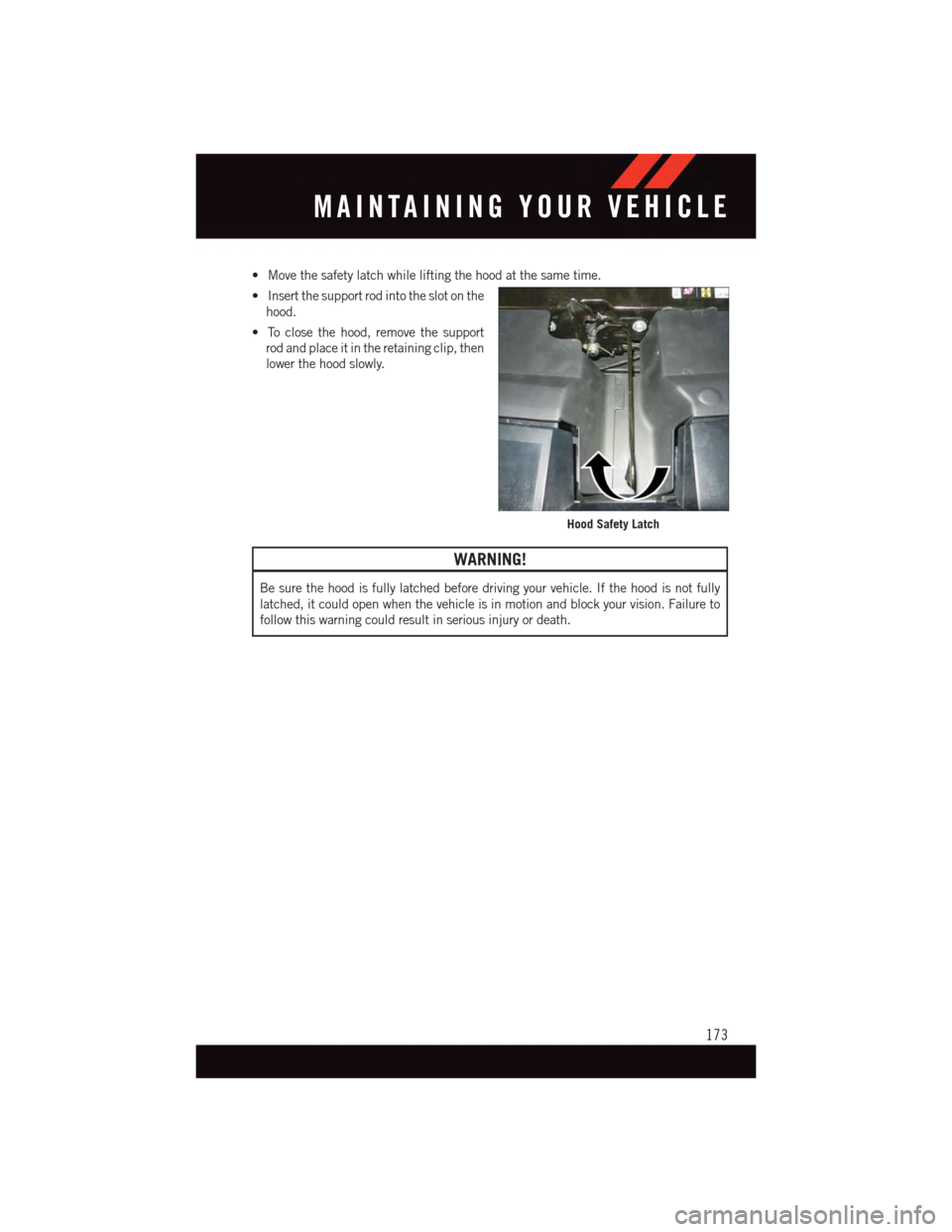
•Movethesafetylatchwhileliftingthehoodatthesametime.
•Insertthesupportrodintotheslotonthe
hood.
•Toclosethehood,removethesupport
rod and place it in the retaining clip, then
lower the hood slowly.
WARNING!
Be sure the hood is fully latched before driving your vehicle. If the hood is not fully
latched, it could open when the vehicle is in motion and block your vision. Failure to
follow this warning could result in serious injury or death.
Hood Safety Latch
MAINTAINING YOUR VEHICLE
173
Page 176 of 220
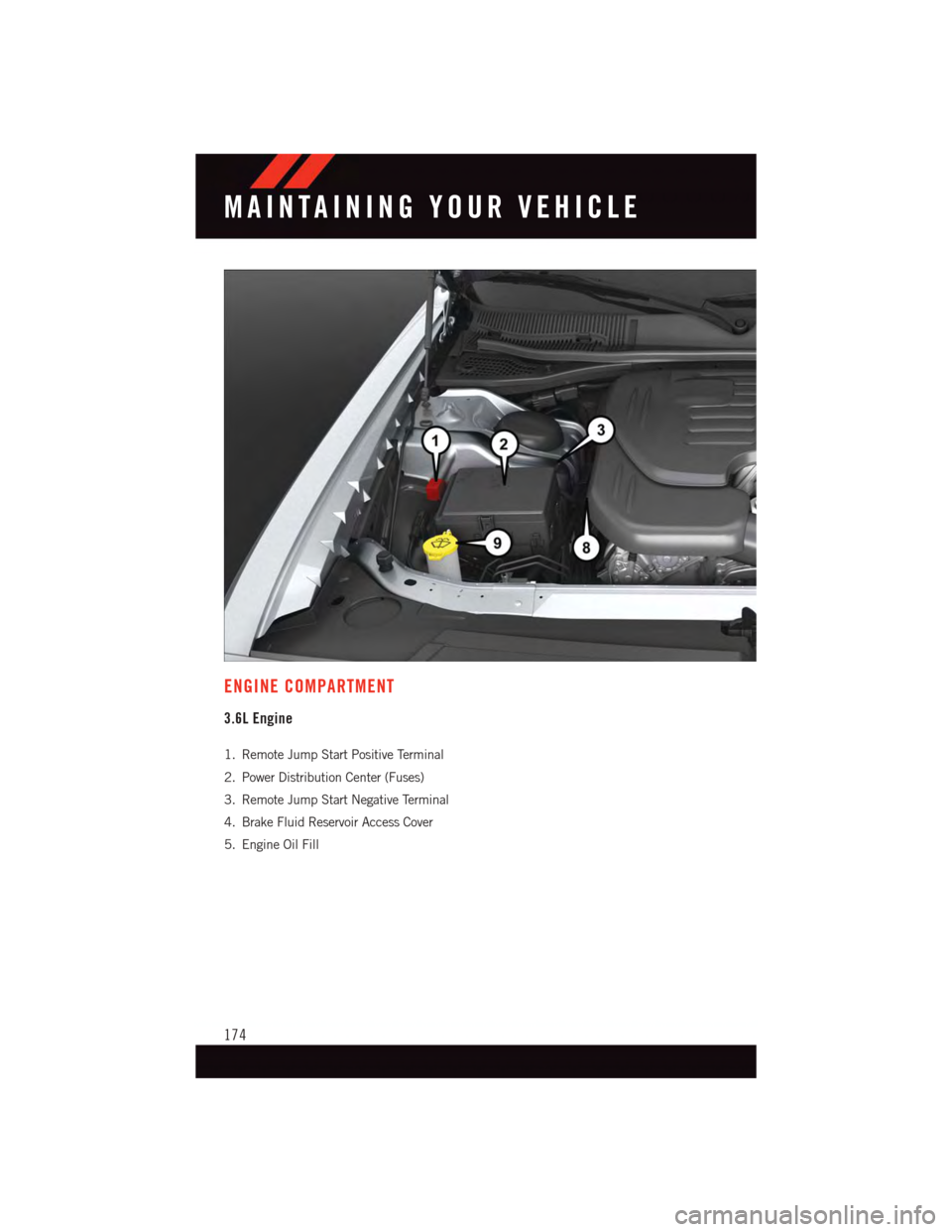
ENGINE COMPARTMENT
3.6L Engine
1. Remote Jump Start Positive Terminal
2. Power Distribution Center (Fuses)
3. Remote Jump Start Negative Terminal
4. Brake Fluid Reservoir Access Cover
5. Engine Oil Fill
MAINTAINING YOUR VEHICLE
174
Page 177 of 220
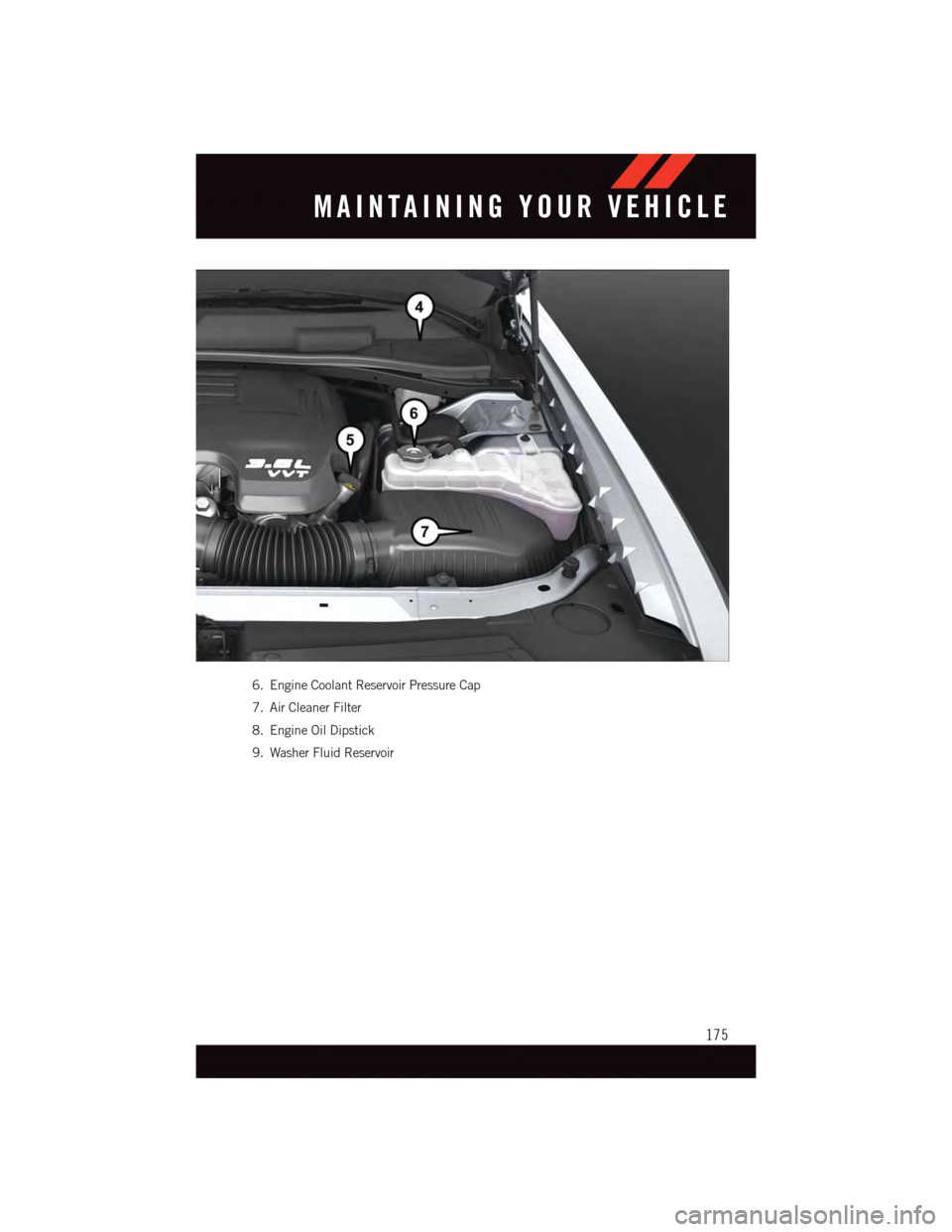
6. Engine Coolant Reservoir Pressure Cap
7. Air Cleaner Filter
8. Engine Oil Dipstick
9. Washer Fluid Reservoir
MAINTAINING YOUR VEHICLE
175
Page 178 of 220
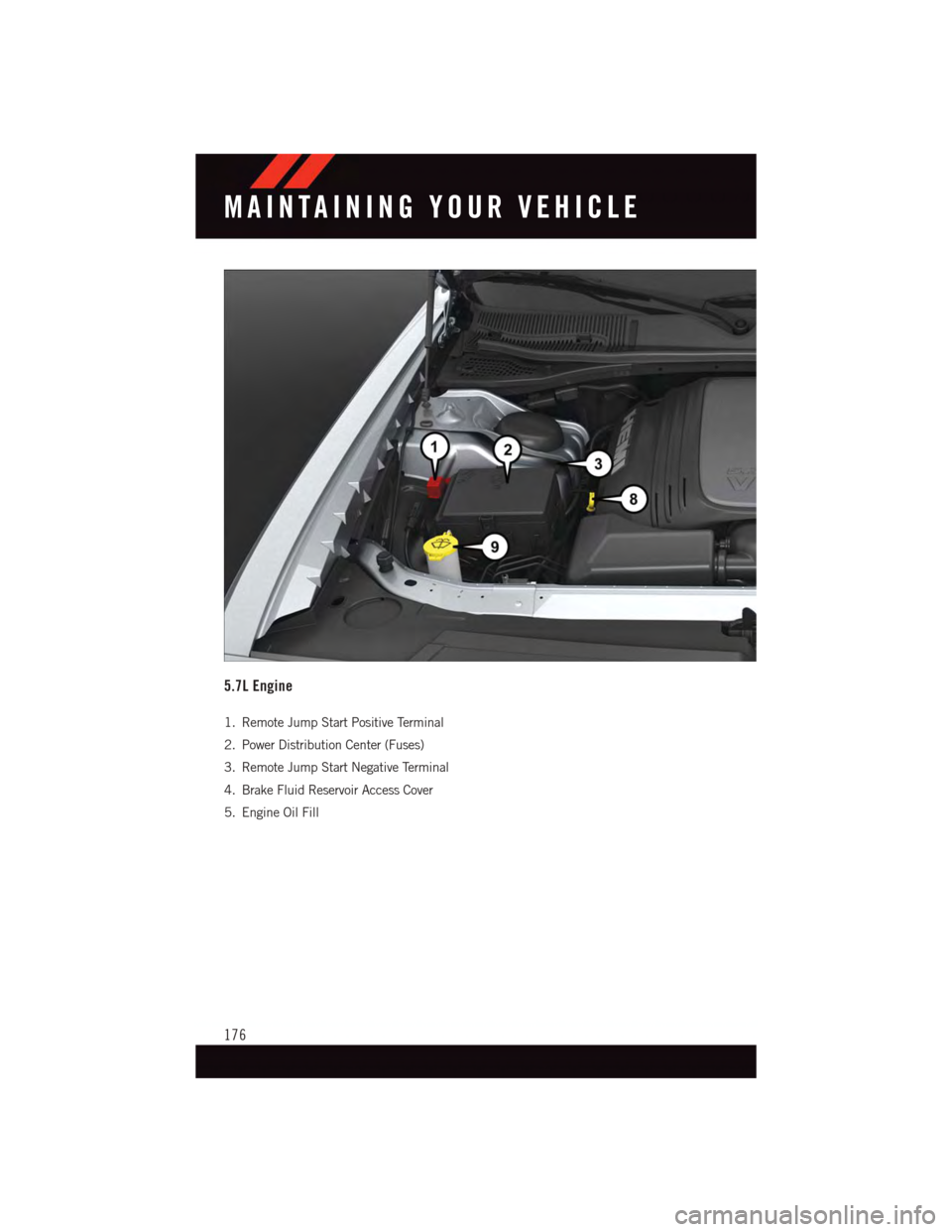
5.7L Engine
1. Remote Jump Start Positive Terminal
2. Power Distribution Center (Fuses)
3. Remote Jump Start Negative Terminal
4. Brake Fluid Reservoir Access Cover
5. Engine Oil Fill
MAINTAINING YOUR VEHICLE
176
Page 179 of 220
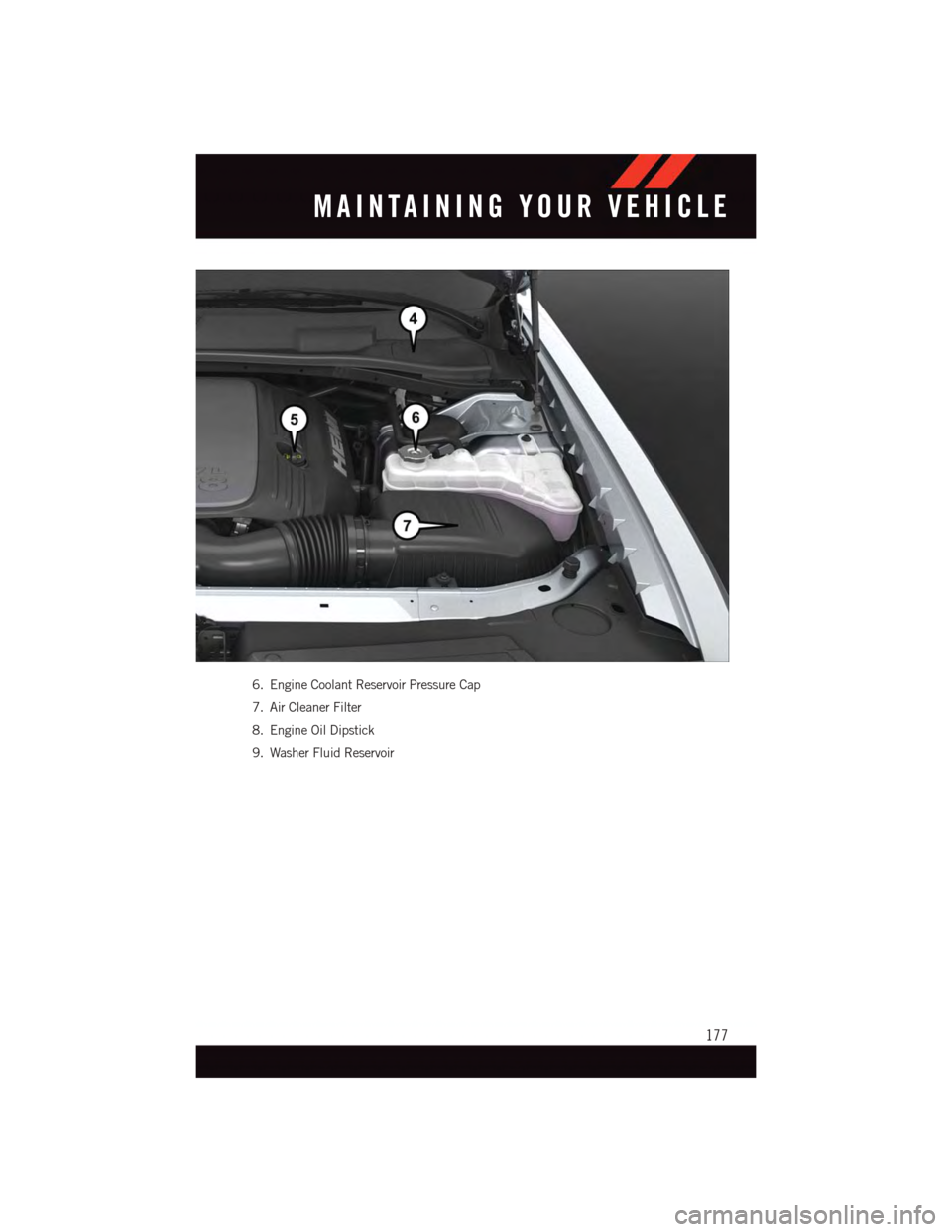
6. Engine Coolant Reservoir Pressure Cap
7. Air Cleaner Filter
8. Engine Oil Dipstick
9. Washer Fluid Reservoir
MAINTAINING YOUR VEHICLE
177
Page 180 of 220
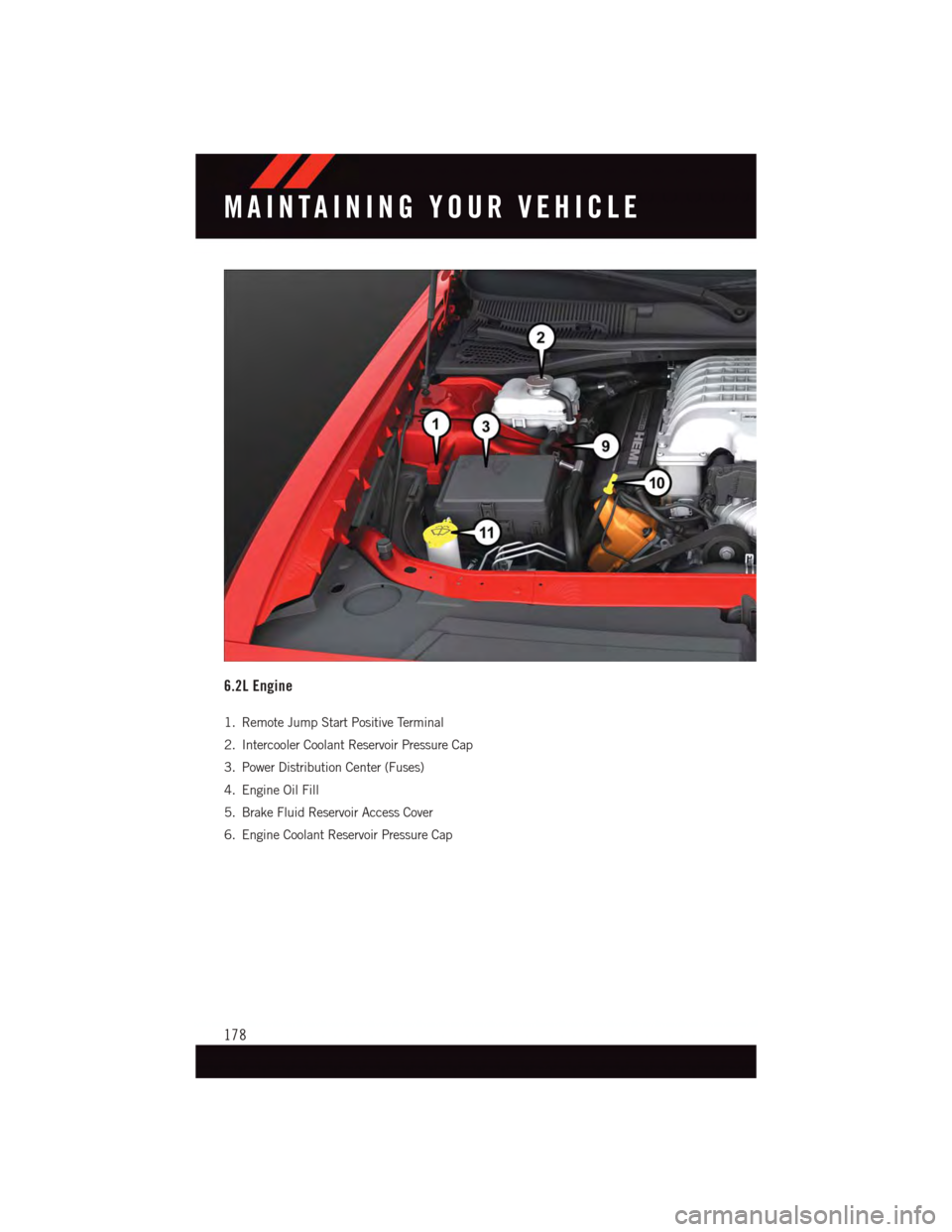
6.2L Engine
1. Remote Jump Start Positive Terminal
2. Intercooler Coolant Reservoir Pressure Cap
3. Power Distribution Center (Fuses)
4. Engine Oil Fill
5. Brake Fluid Reservoir Access Cover
6. Engine Coolant Reservoir Pressure Cap
MAINTAINING YOUR VEHICLE
178